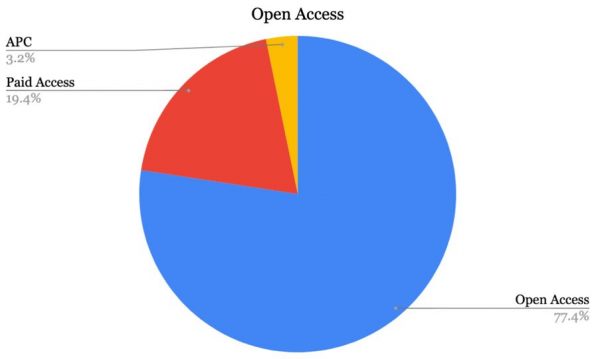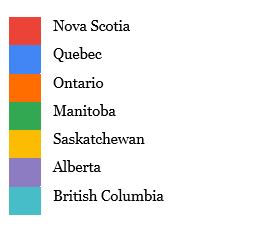CALL member Hannah Steeves, the Instruction & Reference Librarian at the Sir James Dunn Law Library, Dalhousie University (Halifax), recently wrote an article on "Visualizing the Landscape of Canadian Law School Journals". It originally appeared on Slaw.ca on April 6, 2022.
It is reprinted here with permission.
![]() In my role at the Sir James Dunn Law Library, I help facilitate both the creation and dissemination of scholarly knowledge through law journals. As a result, I have developed many questions and curiosities surrounding scholarly publishing practices. While the larger ones require empirical research, a handful seemed easy to answer based on readily available data. Using the information available on the websites of each peer-reviewed law journal affiliated with and published by a Canadian law school, I answered the following questions:
In my role at the Sir James Dunn Law Library, I help facilitate both the creation and dissemination of scholarly knowledge through law journals. As a result, I have developed many questions and curiosities surrounding scholarly publishing practices. While the larger ones require empirical research, a handful seemed easy to answer based on readily available data. Using the information available on the websites of each peer-reviewed law journal affiliated with and published by a Canadian law school, I answered the following questions:
- How many peer-reviewed law journals are affiliated with Canadian law schools and published in-house?*
- How many of these law journals are primarily student-run?**
- How many of these law journals are open access?
- How many of these journals follow the Canadian Guide to Legal Citation (the “McGill Guide”)?***
- What is the length of an article submission (word count)?
- How frequently do these journals publish?
- For fun, how many words per year do these journals publish?
- Which province publishes the highest volume of articles per year?
- Which law school publishes the highest volume of articles per year?
*Not published by a commercial publisher such as Carswell, LexisNexis, Cambridge, Oxford, etc. **Student-run was determined by a statement on the journal’s website specifying student-run or having faculty labelled as participating in only an advisory capacity. ***Any edition. All data was retrieved from the journals’ websites and supplemented with HeinOnline. There are obvious shortcomings in the data I pulled. I did not determine the average word count of a journal article, nor did I include open-access journals published by institutions and organizations that are not affiliated with a Canadian law school. I omitted book reviews and other commentary based on the assumption that other legal scholars more commonly reference articles in subsequent works and courts. I did not cross-reference where each journal was indexed beyond their own website and HeinOnline. These data represent a small, but specific, slice of academic Canadian legal literature.
Question 1: How many peer-reviewed law journals are affiliated with Canadian law schools and published in-house?*
- Dal LJ
- Dal J Leg Stud
- UNBLJ
- McGill J Dispute Resolution
- Inter Gentes: McGill J Intl L & Leg Pluralism
- McGill JL & Health
- JSDLP
- McGill LJ
- Lakehead Law Journal
- Wrongful Conviction L Rev
- Osgoode Hall LJ
- JL & Soc Pol’y
- Ottawa L Rev
- Queen’s LJ
- UTLJ
- UT Fac L Rev
- Critical Analysis L: An Intl & Interdisciplinary L Rev
- JL & Equality
- Indigenous LJ
- Western J of Leg Studies
- Windsor Rev Legal Soc Issues
- Windsor YB Access Just
- Asper Review
- Can J of Human Rights
- Man LJ
- Sask L Rev
- Alta L Rev
- UBC L Rev
- Can J Fam L
- Can J of Comparative & Contemporary L
- Appeal
Question 2: How many of these law journals are primarily student-run?

There are many individuals involved with each step of publishing a journal, from peer reviewers to copy editors. However, it is obvious that law students put significant effort into the scholarly publishing of legal literature. Even journals that have editorial boards composed of faculty members typically have student volunteers for source checking and footnote editing. The work law students put into law school journals is a noteworthy contribution to scholarly work in Canada.
Question 3: How many of these law journals are open access (OA)?

Only one journal has article processing charges (APCs). The University of Toronto Law Journal only provides hybrid OA options and “offers authors whose research has been funded by a national, regional, or international research funder … green and gold open access options to comply with research funding requirements.” It is common for public funding agencies to require researchers to publish in OA journals.2 And while research suggests that scholars value the principles of open access, they remain motivated by traditional scholarly incentives, including publishing in highly ranked journals that support the path to tenure and promotion.3 Though I believe the intention of funders’ OA requirements is to encourage accessibility and dissemination of scholarly knowledge, I have often wondered if these requirements only strengthen the power wielded by for-profit journals as the public funding is going directly to the journals via the APC.
Question 4: How many of these journals follow the Canadian Guide to Legal Citation (the “McGill Guide”)?

Most of the journals reviewed used theMcGill Guide as their citation guide. Only ~7 per cent did not use McGill or offer it as an option to authors.
Question 5: What is the length of an article submission (word count)?


This graph reflects the maximum word limit for article submissions. The University of New Brunswick Law Journal specifies that “[w]hile there are no preliminary restrictions as to manuscript length, the editorial board reserves the right to set such restrictions as a condition of publication.” The Journal of Law and Equality did not specify. For journals with page limits in their submission guidelines, I used a words-per-page counter to convert the page ranges to word limits based on the average number of words per page.
Methodology for questions 6–9:
First, I checked article submission guidelines for the maximum word limits. I excluded book reviews, case comments, etc., based on the assumption that articles are more likely to be cited by other scholars and relied upon by courts. I checked the average number of volumes and issues per year based on the past 10 years to determine each journal’s publication frequency. I reviewed each journal’s five most recent issues to determine the average number of articles published per issue, then I multiplied the average number of articles per issue by the number of issues published each year. Finally, I multiplied the maximum word limit by the average number of articles published each year.
Question 6: How frequently do these journals publish?

Question 7: For fun, how many words per year do these journals publish?


The UNBLJ and JL & Equality do not provide information on word limits and are not accurately reflected in this graph.
Question 8: Which province publishes the highest volume of articles per year?
Ontario has the potential to produce well over 1.5 million words of peer-reviewed legal literature per year. Further examination of author demographics and the areas of law and legal topics addressed would provide insight into who is writing and what they are writing about.
Question 9: Which law school publishes the highest volume of articles per year?
The University of Manitoba Faculty of Law publishes an impressive amount of legal literature. Specifically, the
Manitoba Law Journal states they have five dimensions that contribute to their output of peer-reviewed articles. The term dimension refers to a special topic addressed in each issue. Please note that I do not think that quantity is an indicator of quality. However, identifying journals that produce a significant amount of legal literature and examining their submission guidelines, editorial boards, editorial processes, and policies could provide insight into how to establish an efficient, quality journal. What other interesting things did I notice?
- Many journals have expanded their scope beyond peer-reviewed content. Blogs and podcasts are increasingly common, likely due to their ability to distribute informal scholarly knowledge with expediency.
- Although most journals are not topical, special issues addressing a theme were common.
- None of the journals defined “open access” — they just state that they are OA.
This serves as an introduction to the existing landscape of peer-reviewed law journals published by Canadian law schools. It would also be interesting to review the demographics of authors, the legal areas or topics explored, and subsequent scholarly and court citations. Adding an empirical layer could identify trends regarding submissions and, on a much larger scale, how submission guidelines and editorial processes might impact knowledge creation. ____
The dataset is available here. If you notice any errors, please contact me, and I will make the necessary corrections.